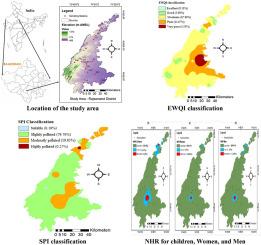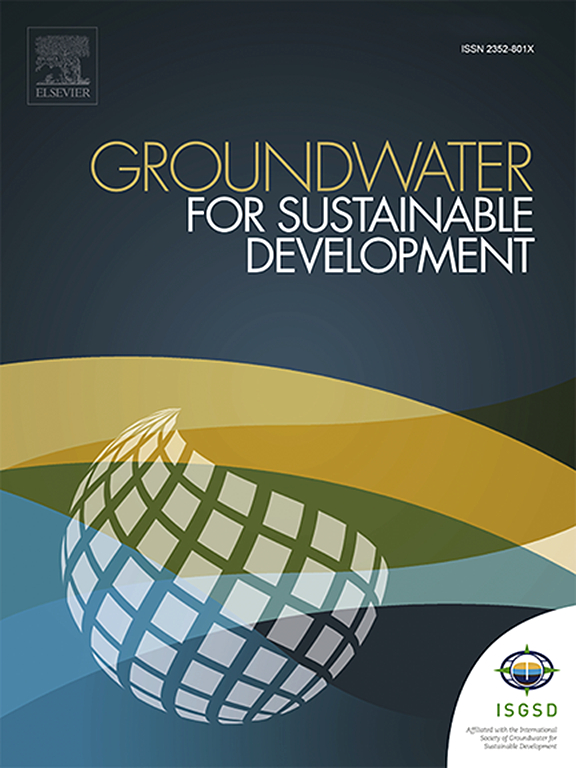Assessing sources of groundwater quality and health risks using graphical, multivariate, and index techniques from a part of Rajasthan, India
IF 4.9
Q2 ENGINEERING, ENVIRONMENTAL
引用次数: 0
Abstract
Groundwater provides sustainable potable water in developing countries like India. However, contaminated groundwater directly affects human health. The United Nation policy is to provide clean water for all by 2030. Therefore, groundwater samples collected from a part of Rajasthan, India were analysed for chemical parameters to identify the sources of groundwater quality variation and associated health risks. To achieve this objective, a comprehensive approach of entropy water quality index (EWQI), Piper and Gibbs diagrams, ionic ratios (IR), synthetic pollution index (SPI), principal component analysis (PCA), and non-carcinogenic health risk (NHR) methods were used. EWQI revealed that groundwater quality is not fit for drinking in 81.86% of the area due to higher TDS, Na+, , , , and contents, which was statistically significant by ANOVA test. Modified Piper's diagram identified Ca2+ - , Ca2+ - , Na+- , and Na+ - types in 36.67%, 22.73%, 13.64%, and 27.27% of groundwater samples, respectively. Gibbs diagrams illustrated that 59.09% and 40.81% of groundwater samples fell in the rock and evaporation domains, respectively. IR demonstrated that geogenic processes (mineral dissolution, ion exchange, and evaporation) and anthropogenic activities cause groundwater quality degradation. PCA indicated that PC1 has high loadings of TDS, Mg2+, Na+, , and , PC2 shows high loadings of pH and , and PC3 represents high loadings of , K+, and , which was further supported by t-test analysis. SPI revealed that 99.82% of the study area is polluted. NHR values (0.03 to 1.68, 0.02 to 1.29, and 0.03 to 1.30 for children, women, and men, respectively) showed that long-term exposure to and -containing drinking water poses a higher health risk to children compared to men and women. Regular water quality monitoring, sanitation facilities, limited application of agrochemicals, etc. were suggested. Such a study would aid environmental public health programs.

利用图形、多元和指数技术评估印度拉贾斯坦邦部分地区地下水质量和健康风险的来源
地下水为印度等发展中国家提供了可持续的饮用水。然而,受污染的地下水会直接影响人类健康。联合国的政策是到 2030 年为所有人提供清洁水。因此,对从印度拉贾斯坦邦部分地区采集的地下水样本进行了化学参数分析,以确定地下水水质变化的来源和相关的健康风险。为实现这一目标,采用了熵水质指数(EWQI)、皮珀图和吉布斯图、离子比率(IR)、合成污染指数(SPI)、主成分分析(PCA)和非致癌健康风险(NHR)等综合方法。EWQI 显示,由于 TDS、Na+、Cl-、SO42-、NO3- 和 F- 含量较高,81.86%的地区地下水质量不适合饮用,经方差分析检验,差异具有统计学意义。修正的皮珀图显示,36.67%、22.73%、13.64%和 27.27%的地下水样本中存在 Ca2+ - HCO3-、Ca2+ - Cl-、Na+ - Cl-和 Na+ - HCO3-类型。吉布斯图显示,分别有 59.09% 和 40.81% 的地下水样本属于岩石域和蒸发域。红外光谱表明,地质作用(矿物溶解、离子交换和蒸发)和人为活动导致地下水水质恶化。PCA 表明 PC1 的 TDS、Mg2+、Na+、Cl- 和 SO42- 负荷较高,PC2 的 pH 和 F- 负荷较高,PC3 的 NO3-、K+ 和 HCO3- 负荷较高,t 检验分析进一步证实了这一点。SPI 显示,99.82% 的研究区域受到污染。儿童、女性和男性的 NHR 值(分别为 0.03 至 1.68、0.02 至 1.29 和 0.03 至 1.30)表明,与男性和女性相比,长期接触含 NO3- 和 F-的饮用水对儿童的健康造成的风险更高。建议定期进行水质监测、建立卫生设施、限制农用化学品的使用等。这样的研究将有助于环境公共卫生计划。
本文章由计算机程序翻译,如有差异,请以英文原文为准。
求助全文
约1分钟内获得全文
求助全文
来源期刊

Groundwater for Sustainable Development
Social Sciences-Geography, Planning and Development
CiteScore
11.50
自引率
10.20%
发文量
152
期刊介绍:
Groundwater for Sustainable Development is directed to different stakeholders and professionals, including government and non-governmental organizations, international funding agencies, universities, public water institutions, public health and other public/private sector professionals, and other relevant institutions. It is aimed at professionals, academics and students in the fields of disciplines such as: groundwater and its connection to surface hydrology and environment, soil sciences, engineering, ecology, microbiology, atmospheric sciences, analytical chemistry, hydro-engineering, water technology, environmental ethics, economics, public health, policy, as well as social sciences, legal disciplines, or any other area connected with water issues. The objectives of this journal are to facilitate: • The improvement of effective and sustainable management of water resources across the globe. • The improvement of human access to groundwater resources in adequate quantity and good quality. • The meeting of the increasing demand for drinking and irrigation water needed for food security to contribute to a social and economically sound human development. • The creation of a global inter- and multidisciplinary platform and forum to improve our understanding of groundwater resources and to advocate their effective and sustainable management and protection against contamination. • Interdisciplinary information exchange and to stimulate scientific research in the fields of groundwater related sciences and social and health sciences required to achieve the United Nations Millennium Development Goals for sustainable development.
 求助内容:
求助内容: 应助结果提醒方式:
应助结果提醒方式:


